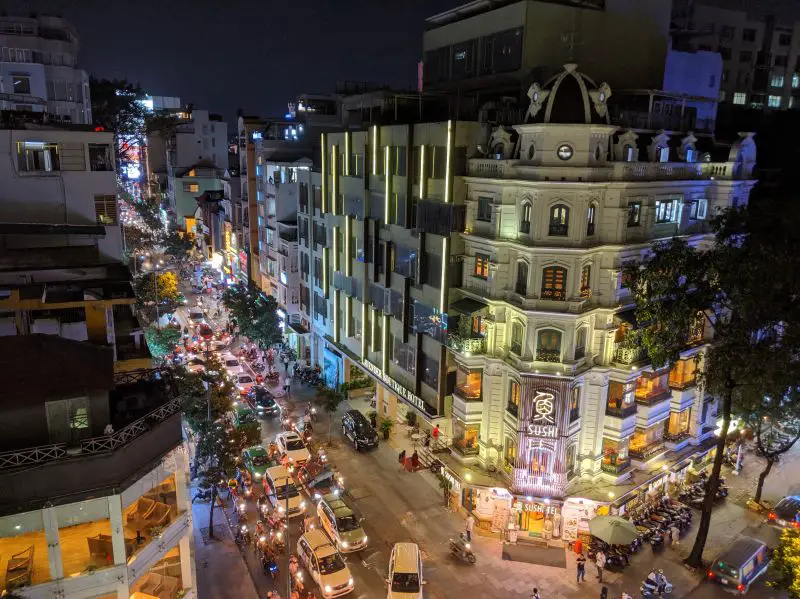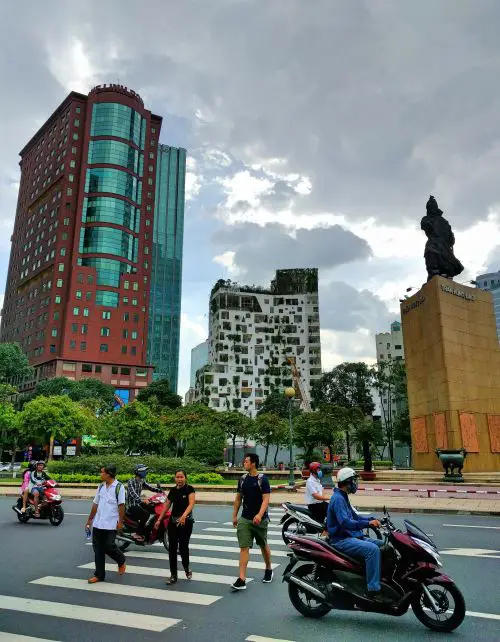Whenever someone visits us in Ho Chi Minh City, Vietnam, we tend to walk a lot in the city. It’s easier for us to walk around District 1 as most of the main attractions are located there. Plus, we get to spend time outside and burn some calories after eating some yummy foods.
Even though walking is a form of transportation, it’s not the easiest to cross the streets in Vietnam.
Don’t laugh, but the experience can be super intimidating, chaotic, and scary for first-time visitors, especially with hundreds of cars and motorbikes heading in the same or opposite direction of where you’re crossing.
We did a family trip to Vietnam for the first time in 2012 and Hanoi was our first stop. It took us about 5 minutes for our group of 6 to cross the street from our hotel to a restaurant. We chained our arms and waited until there was a break to dash across. (In hindsight – Not a good idea.) Every time a motorbike headed in our way, we looked like a deer in the headlights.
Now that we’ve lived in Ho Chi Minh for over three years, we can say that we’ve learned our mistakes and managed to cross streets without any injuries.
In this post, we’ll teach you how to cross the road safely in Vietnam. After a few tries, you’ll gain more confidence to cross the street like a local.

Things to Know About Crossing the Roads in Vietnam
- Pedestrians do not have the “right of way” here compared to the U.S. and other Western countries. Vehicles such as buses, trucks, and motorbikes do not need to stop for pedestrians.
- Traffic lights are “suggestions.” Depending on the traffic conditions, vehicles may run through the red lights or squeeze their way to the other side of the road when traffic is coming from all directions. Therefore, pedestrians are welcome to cross the road anywhere and at any time and within safe conditions.
- Let the larger vehicle pass. Do not attempt to run or cross the street with a bus or truck heading in your direction.
As a heads up, the vehicles are not traveling too fast. No more than 15-30 kph (9.3-18.6 mph) during the traffic times.
- Consider crossing the roads during the off-hours. The morning commute hours (7:00am-9:00am) and afternoon commute hours (4:30-7:00pm) tend to be the heaviest traffic. It will be more challenging to cross the street as thousands of motorbikes head to or return from work. It’s still doable, but you’ll need to be extra careful and shuffle your way across. The amount of time will take twice as long to cross.
In the larger cities, such as Ho Chi Minh City and Hanoi, the sidewalks are not pedestrian-friendly. The sidewalk conditions are not the best as they may be crumbling apart or non-existent. Also, sidewalks are used for motorbike parking.

- While Vietnam is safe to travel to, stay vigilant with your stuff when crossing the street. If you have a purse, handbag, or smartphone, be sure that they’re secured next to your body or out of sight. We’ve heard of foreigners having these items snatched from their hands when walking around the main touristy areas and where expats live.
In Ho Chi Minh City, we’ve seen locals help tourists cross the heavily used Ton Duc Thang Street from Nguyen Hue Walking Street to Saigon River, but for a fee. It’s up to you whether you want to give a tip or not.
How to Cross Vietnam’s Streets Safely
- Figure out where you’ll cross the road, whether it’s at a crosswalk or on the side of the road.
*Note: While we’ve instinctively been taught to use the crosswalks, you do not need to use them here. Many of the crosswalks may be a few meters away from where you need to go so it’s often faster to cross the street anywhere.
2. Stop on the side of the road and look both ways. Watch to see if motorbikes are heading in your direction in the opposite way. Do not look down on your photo or look away from the streets.
3. Stay calm, walk straight, and cautiously as motorbikes and cars come towards you. You may raise your hand in the air as an extra signal that you’re crossing the street.
Important Tips: If there is a local crossing in the same place as you, you can follow the other person’s lead.
Do not attempt to cross the street if a bus or a truck heading to you. The bigger vehicles will always win and have right of way. Just pause in the middle of the road until the larger vehicle passes.
4. Do not stop in the middle of the road or run/dash across the street. The motorbike drivers typically can see your walking pattern and will go around you. Once you dash across, they’ll be confused and cannot predict how you’ll move. Your actions will cause an accident.
5. Continue to walk across carefully. Even if the crosswalk has turned to a stop signal, you could continue or wait until the light is green to finish crossing the street. This is where you’ll need to make the judgment call.
6. Congratulations! You finally made it to the other side of the street and can take a sigh of relief.

If you need a visual on how the steps above works, check out this video. (Note: It’s not our video but it sums how to conquer street crossing.)
Final Thoughts
What are your thoughts about crossing Vietnam’s streets? If you’ve been to Vietnam before, let us know what your experience is like in the comments below.
At first, it is a bit crazy, but after a few tries, it’ll be second nature to travel across the street at any time of the day.

